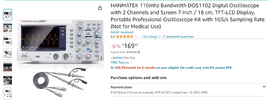I've never owned a 'scope until now, and I'd like to use it to help with alignments and audio adjustments on my personal equipment. I am a big stickler for clean audio, so I felt it was time to invest in a piece of equipment that I could use to help me achieve that.
As I've never owned a 'scope until now, I've also never used one, so I don't know what I am doing. I do understand that it's a no-no to feed RF straight into the input of the 'scope, so I'll need to fashion an RF sampler of sorts. I'm considering wrapping a few turns of wire around my dummy load and clipping the test lead to the ends. I'd imagine there should be enough coupling there to get a usable RF sample.
Other than that, I'm flying blind. This thing has several buttons and knobs - I have no idea what they do. The included manual is poor ching-lish.
This is the model I purchased. Don't laugh. It's not a Tek, but it was inexpensive and better than the one I had before, which is not one. Amazon product ASIN B0833YFNKP
Are there any special settings I need to configure before I start using it to measure audio and carrier waveforms? What else can I use this thing for other than that? Thanks!
As I've never owned a 'scope until now, I've also never used one, so I don't know what I am doing. I do understand that it's a no-no to feed RF straight into the input of the 'scope, so I'll need to fashion an RF sampler of sorts. I'm considering wrapping a few turns of wire around my dummy load and clipping the test lead to the ends. I'd imagine there should be enough coupling there to get a usable RF sample.
Other than that, I'm flying blind. This thing has several buttons and knobs - I have no idea what they do. The included manual is poor ching-lish.
This is the model I purchased. Don't laugh. It's not a Tek, but it was inexpensive and better than the one I had before, which is not one. Amazon product ASIN B0833YFNKP
Are there any special settings I need to configure before I start using it to measure audio and carrier waveforms? What else can I use this thing for other than that? Thanks!

